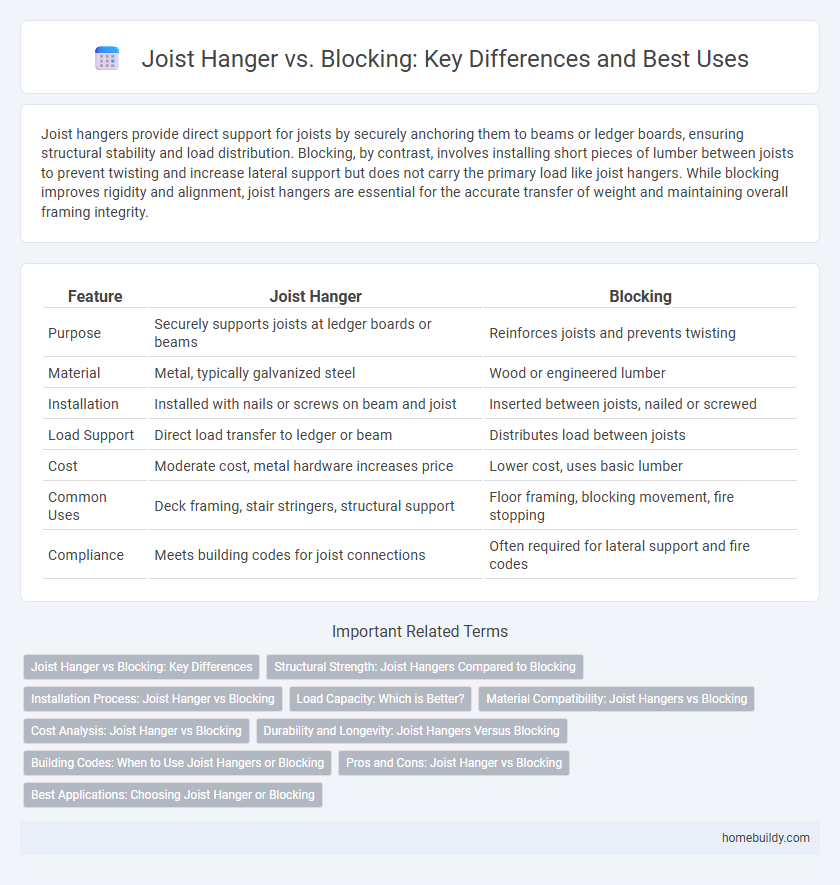Joist hangers provide direct support for joists by securely anchoring them to beams or ledger boards, ensuring structural stability and load distribution. Blocking, by contrast, involves installing short pieces of lumber between joists to prevent twisting and increase lateral support but does not carry the primary load like joist hangers. While blocking improves rigidity and alignment, joist hangers are essential for the accurate transfer of weight and maintaining overall framing integrity.
Table of Comparison
| Feature | Joist Hanger | Blocking |
|---|---|---|
| Purpose | Securely supports joists at ledger boards or beams | Reinforces joists and prevents twisting |
| Material | Metal, typically galvanized steel | Wood or engineered lumber |
| Installation | Installed with nails or screws on beam and joist | Inserted between joists, nailed or screwed |
| Load Support | Direct load transfer to ledger or beam | Distributes load between joists |
| Cost | Moderate cost, metal hardware increases price | Lower cost, uses basic lumber |
| Common Uses | Deck framing, stair stringers, structural support | Floor framing, blocking movement, fire stopping |
| Compliance | Meets building codes for joist connections | Often required for lateral support and fire codes |
Joist Hanger vs Blocking: Key Differences
Joist hangers provide metal support brackets that securely anchor joists to beams or ledgers, ensuring enhanced load distribution and structural stability. Blocking consists of solid wood or engineered lumber pieces installed between joists to prevent twisting and improve load transfer. Unlike blocking, joist hangers offer a more direct mechanical connection, reducing movement and increasing the durability of the framing system.
Structural Strength: Joist Hangers Compared to Blocking
Joist hangers provide superior structural strength compared to blocking by securely fastening joists to beams with metal connectors that resist shear and uplift forces. Unlike blocking, which relies on nails driven through wood-to-wood contact, joist hangers distribute loads evenly and reduce the risk of joist rotation and movement. Building codes often recognize joist hangers as a more reliable method for load transfer in floor framing systems.
Installation Process: Joist Hanger vs Blocking
Joist hanger installation involves securing metal brackets to the ledger board and the joists using nails or screws designed for structural support, ensuring a strong connection that simplifies alignment and load distribution. Blocking requires cutting and fitting solid wood pieces between joists, then fastening them with nails or screws, which can be more labor-intensive and less precise in maintaining joist spacing. Joist hangers offer a more uniform and reliable installation process, reducing installation time and enhancing structural integrity compared to traditional blocking methods.
Load Capacity: Which is Better?
Joist hangers provide superior load capacity compared to blocking by securely anchoring joists to beams or ledgers, distributing weight evenly and reducing movement. Blocking offers lateral support but does not effectively bear vertical loads, making it less reliable for structural integrity under heavy loads. For maximizing load capacity in decking and framing projects, joist hangers are the preferred choice due to their engineered design and metal construction.
Material Compatibility: Joist Hangers vs Blocking
Joist hangers are typically made from galvanized steel, providing excellent durability and resistance to corrosion, making them compatible with wood, engineered lumber, and steel. Blocking, usually constructed from solid wood or engineered wood, relies on direct wood-to-wood contact, which may lead to varying performance depending on wood species and moisture content. The material compatibility of joist hangers offers a more robust and standardized connection compared to blocking, enhancing structural integrity in framing applications.
Cost Analysis: Joist Hanger vs Blocking
Joist hangers typically offer a cost-effective solution by reducing labor time and ensuring a stronger, more reliable connection compared to blocking. While blocking requires additional lumber and increased installation time, driving up overall expenses, joist hangers minimize material waste and simplify assembly, leading to lower total costs. Construction projects using joist hangers benefit from enhanced structural integrity and faster installation, resulting in better budget management and fewer post-construction repairs.
Durability and Longevity: Joist Hangers Versus Blocking
Joist hangers offer superior durability compared to blocking by providing metal reinforcement that resists wood splitting and decay over time. Blocking, typically made of wood pieces between joists, is more prone to moisture damage and warping, reducing its longevity. For long-lasting structural support, joist hangers ensure consistent load distribution and enhanced resistance to environmental wear.
Building Codes: When to Use Joist Hangers or Blocking
Building codes typically require joist hangers for securing joists in situations where load transfer and lateral stability are critical, such as in deck construction or where joists meet beams. Blocking is often acceptable for shorter spans or when joists run parallel and need lateral support but may not meet code requirements for structural connections in high-load areas. Compliance with local building codes ensures the correct use of joist hangers or blocking, enhancing safety and structural integrity in wood framing.
Pros and Cons: Joist Hanger vs Blocking
Joist hangers provide strong, secure connections by supporting joists directly on beams or ledgers, ensuring structural integrity and reducing sagging, while blocking improves lateral stability and load distribution between joists but requires more material and labor. Joist hangers allow for easier installation and adjustment of joist alignment compared to blocking, which can complicate framing due to precise measurements and cutting. However, blocking offers enhanced shear resistance and fireblocking benefits that joist hangers alone cannot provide, making both methods valuable depending on specific structural requirements.
Best Applications: Choosing Joist Hanger or Blocking
Joist hangers provide superior support and load transfer for framing connections, making them ideal for open constructions and areas with heavy structural demands. Blocking offers increased lateral stability and resistance to twisting, best suited for reinforcing joists in close spacing or enhancing shear strength in enclosed frameworks. Selecting between joist hangers and blocking depends on factors like load requirements, framing layout, and desired structural rigidity, ensuring optimal performance and safety.
Joist hanger vs blocking Infographic

 homebuildy.com
homebuildy.com